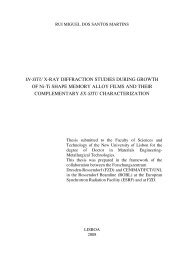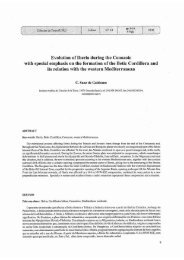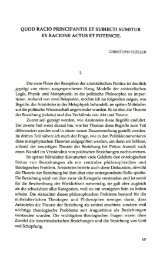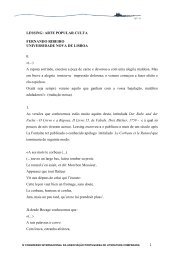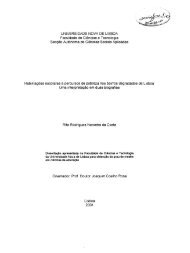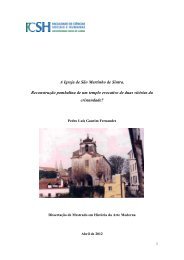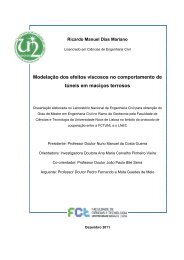Elias Manuel Morgado Pinheiro Dissertação de Mestrado em ...
Elias Manuel Morgado Pinheiro Dissertação de Mestrado em ...
Elias Manuel Morgado Pinheiro Dissertação de Mestrado em ...
Create successful ePaper yourself
Turn your PDF publications into a flip-book with our unique Google optimized e-Paper software.
graves, it was limited to a single axe or projectile weapon. In contrast, in Sintashta<br />
culture graves, a great number of different weapons can be found, as well as numerous<br />
projectile points. At the same time, the frequency of weapons burials increased<br />
drastically. David Anthony suggests an increase from less than 10% of all graves<br />
containing weapons in earlier Bronze Age cultures, to a maximum of 54% of adult<br />
graves in Sintashta culture graves 56 .<br />
Another clear indicator of increased conflict is the <strong>em</strong>ergence of new weapons.<br />
This <strong>de</strong>velopment in armaments can best be seen in projectile points. Ol<strong>de</strong>r lanceolate<br />
arrowheads with flat bases became longer. A new type of projectile-st<strong>em</strong>med point<br />
appeared, consisting of a long (avg.4-10cm long) bla<strong>de</strong> with a thick medial ridge. Being<br />
st<strong>em</strong>med, it was probably used in javelins rather than in arrows, as mentioned before.<br />
Besi<strong>de</strong>s these projectile points, a new type of socketed spear head, ma<strong>de</strong> of bronze or<br />
copper and heavier than its pre<strong>de</strong>cessors was also found 57 . Because of its mass and<br />
weight, this spearhead might have been used in close combat rather than as a throwing<br />
weapon.<br />
arisen.<br />
In this period of martial technological <strong>de</strong>velopment, the war chariot might have<br />
According to Littauer and Crouwel, the war chariot is a superfluous artefact in<br />
the steppe, mainly because of the existence of a more suitable alternative, the horse.<br />
That might have been the case in conventional tribal warfare, consisting on occasional<br />
skirmishes and cattle raids. This type of conflict is characterized by small and quick<br />
engag<strong>em</strong>ents. Rather than being used as a weapons platform, the horse was probably<br />
used to create a surprise el<strong>em</strong>ent, and later a swift retreat. In comparison with mo<strong>de</strong>rn-<br />
day horses, Bronze Age horses were little more than sturdy ponies. While some could<br />
carry a man, they certainly could not endure the hardships of battle. They could not<br />
carry a fully armoured warrior for long periods of time, and being an animal with a fight<br />
or flight response heavily geared towards flight, in the case of mares and geldings, or of<br />
extr<strong>em</strong>e aggression, in the case of stallions; it would be extr<strong>em</strong>ely difficult to manage in<br />
any sort of formation or tactical use. While this was no serious drawback in earlier tribal<br />
warfare, when the horse served as transportation to light-armoured warriors, during the<br />
Sintashta period, where large-scale battles were fought between large groups of<br />
56 Anthony, 2007, p395<br />
57 Anthony, 2007, p395<br />
34







